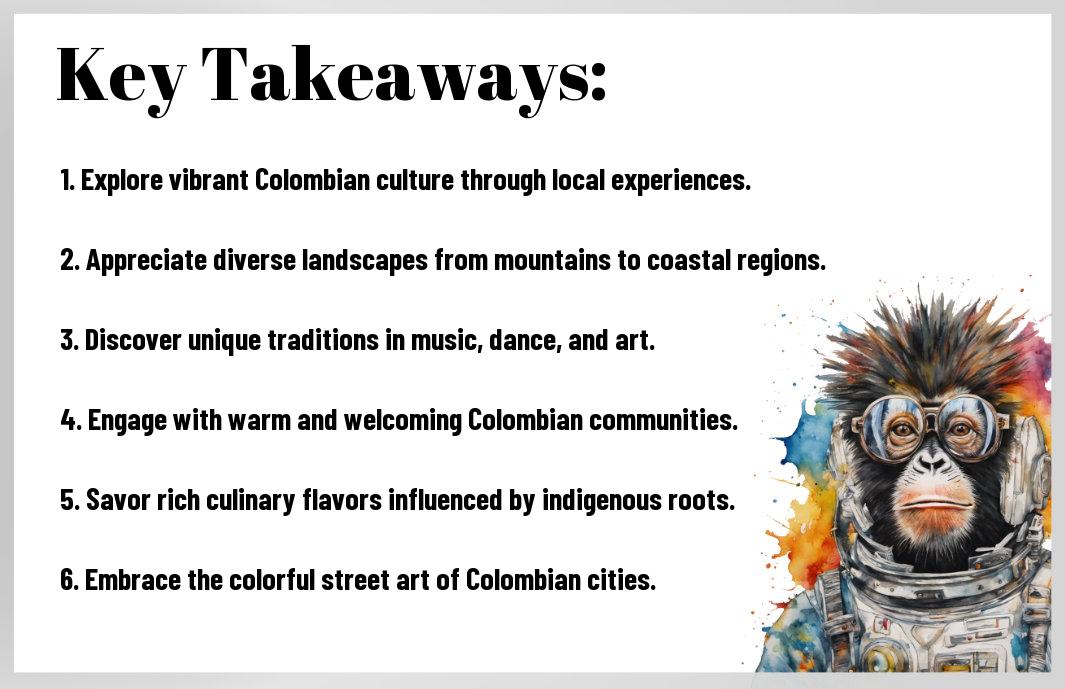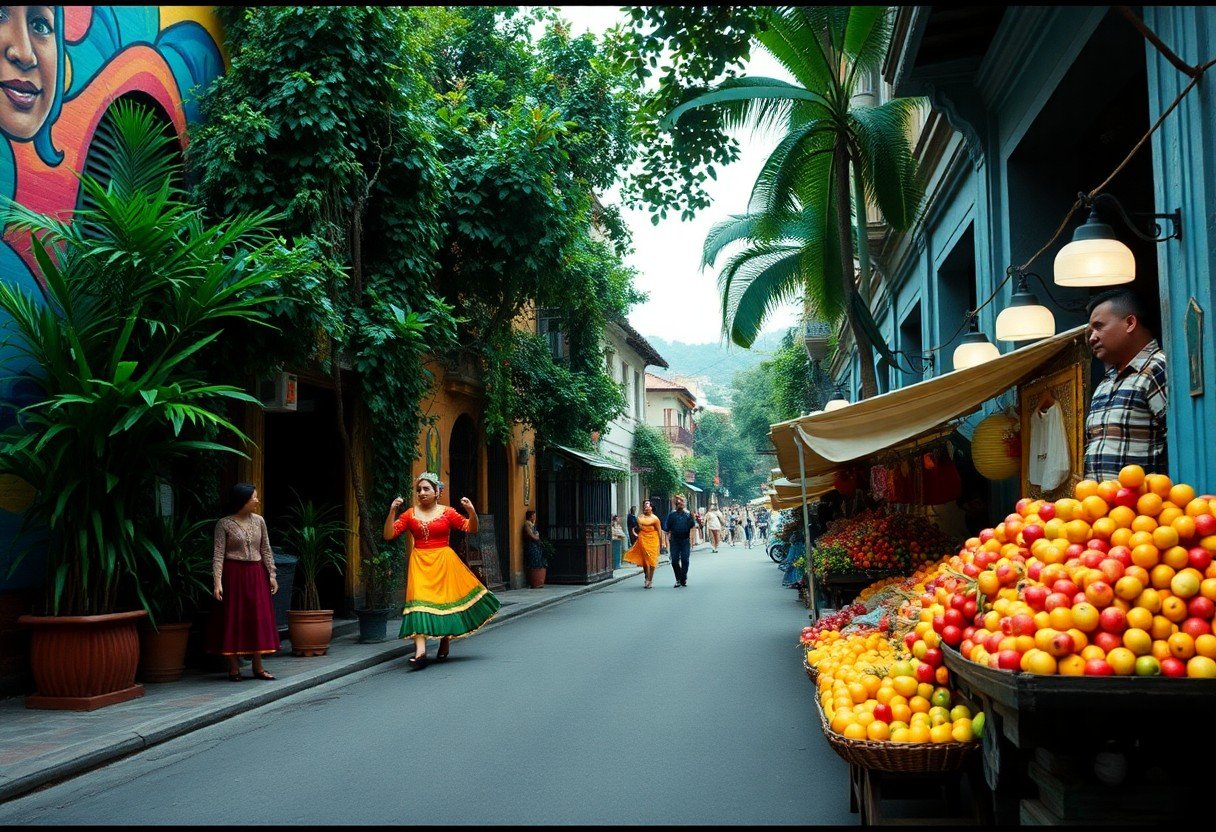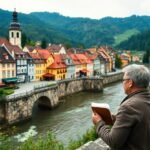With a rich tapestry of vibrant cultures and breathtaking landscapes, Colombia invites you to explore its dynamic essence through the lens of Jesper Jacobi’s experiences. This post will take you on a journey through Colombia’s colorful traditions, diverse communities, and the profound warmth of its people. You will discover how Colombia’s unique blend of history and modernity offers an unforgettable experience that beckons you to immerse yourself in its compelling story. Join us as we research into the many facets of Colombia that make it a must-visit destination.

Colombian Cultural Landscape
To appreciate Colombia fully, you must immerse yourself in its vibrant cultural landscape, characterized by a rich tapestry of traditions, languages, and artistic expressions. Each region offers unique customs and perspectives, reflecting the diverse influences that have shaped this nation. From the bustling streets of Bogotá to the rhythmic beats of Barranquilla’s Carnaval, Colombia invites you to explore its colorful culture and the warm hospitality of its people.
Regional Diversity and Traditions
Before exploring into Colombia’s cultural richness, it’s necessary to understand the regional diversity that defines the country. Each area boasts its own distinct traditions, rituals, and festivals, influenced by the indigenous populations, Afro-Colombian heritage, and colonial history. You may find yourself celebrating the enchanting music of the Pacific coast or enjoying the vibrant arts of Medellín, revealing the multifaceted identity of Colombia.
Historical Context and Heritage
Regional influences have shaped Colombia’s cultural identity significantly, showcasing a blend of indigenous, African, and Spanish heritages. This complexity offers you a deeper understanding of Colombian society and its various artistic expressions. From the ancient rituals of indigenous groups to the colonial architecture visible in cities like Cartagena, these historical legacies are visible in everyday life, as they inform contemporary cultural practices and social dynamics.
Traditions play a pivotal role in conveying the historical context and heritage of Colombia. Festivals, dances, and local rites honor the past and unite communities, providing insight into your cultural experience. For instance, the Día de las Velitas or the Festival of Barranquilla highlights both religious beliefs and indigenous practices, fostering a sense of community while showcasing regional pride. You will discover that Colombia’s cultural landscape is not just a product of its history, but a living, evolving expression of its people.
Visual Journey Through Colors
One of the most captivating aspects of Colombia is its vibrant use of color, which reflects the country’s rich cultural tapestry. As you explore various regions, you will be enchanted by the strikingly painted houses, traditional costumes, and artisanal crafts that showcase a blend of indigenous, African, and Spanish influences. Each color tells a story, inviting you to discover the unique heritage and artistic spirit that define Colombian identity.
Traditional Art and Architecture
Among the highlights of Colombia’s visual journey are its traditional art forms and architectural styles. The iconic colonial buildings in cities like Cartagena and Bogotá stand as testaments to a history woven with cultural influences. As you walk through these vibrant neighborhoods, you will appreciate the intricate details of hand-painted tiles, ornate facades, and lively murals, all of which contribute to the nation’s artistic narrative.
Festival Colors and Celebrations
One of the most breathtaking experiences in Colombia is during the festivals, where colors explode in celebrations that enhance the cultural landscape. You’ll witness parades adorned with elaborate costumes, vibrant decorations, and lively performances that showcase the nation’s artistic expression, marking moments of joy and community spirit.
To truly appreciate the essence of Colombian culture, immerse yourself in the rich tapestry of festival colors and celebrations. Events like Barranquilla’s Carnival and the Flower Festival in Medellín are not just spectacles; they are captivating displays of artistic talent and cultural pride. Engaging with these lively happenings allows you to connect with the soul of Colombia, where every color and dance step resonates with history and tradition.
Daily Life and Social Dynamics
Once again, you will encounter a vibrant interplay of traditions and modernity in Colombia’s daily life. The rich tapestry of cultural expressions is evident in the colorful markets, lively festivals, and the spirited conversations of citizens. As you dive deeper, you may reflect on how historical perspectives, such as those found in American Psychiatry, can shape our understanding of mental health in social interactions.
Urban and Rural Contrasts
Urban life in Colombia is characterized by dynamic cityscapes, bustling markets, and an array of cultural experiences. Here, you will find a blend of modern infrastructure and historical architecture, offering a unique backdrop for daily interactions. In contrast, rural areas provide a slower pace, where traditions are closely tied to agriculture, fostering a strong sense of community.
Community Interactions
Rural Colombia showcases a lifestyle defined by close-knit relationships and communal activities. Your experiences in these areas will highlight the significance of gatherings and shared responsibilities among neighbors, creating a sense of belonging.
Dynamics within community interactions emphasize cooperation and support among residents. You’ll often witness spontaneous collaborations, whether it’s during agricultural harvests or local festivities. Engaging in these communal practices offers you insights into the collective spirit that defines the essence of life in rural Colombia.
Culinary Experiences
For those who commence on a culinary journey through Colombia, the vibrant flavors and rich traditions offer an unforgettable experience. You will discover a diverse array of dishes that reflect the country’s cultural heritage and natural bounty. From street vendors selling arepas to upscale restaurants serving intricate gourmet meals, you will find that each bite tells a story about Colombia’s colorful past and modern evolution.
Traditional Dishes and Ingredients
Beside the famous bandeja paisa, a hearty dish featuring beans, rice, avocado, and meat, Colombian cuisine is full of unique ingredients such as yuca, plantains, and a variety of tropical fruits. You’ll enjoy meals that are not just about sustenance but are also a showcase of regional bounty, blending flavors in innovative ways.
Regional Food Culture
After exploring traditional dishes, you’ll notice that Colombia’s regional food culture is as diverse as its landscapes. Each region boasts its own specialties and culinary practices which are deeply rooted in local customs and traditions. You will appreciate how geography influences the ingredients, from the coastal seafood in Cartagena to the hearty stews of the Andes.
And as you probe deeper into Colombia’s regional food culture, you’ll find that each area offers a distinct culinary identity shaped by its climate, geography, and cultural history. In the Caribbean, dishes are often spiced with tropical influences, while the Andes provide hearty meals that focus on grains and potatoes. You might explore how indigenous practices meld with African and Spanish culinary traditions, showcasing a vibrant tapestry of tastes across the country.
Artistic Expression
All around Colombia, a vibrant kaleidoscope of artistic expression captures your imagination. From traditional crafts to contemporary masterpieces, this South American gem showcases the rich cultural heritage and innovative spirit of its people. Whether you find yourself in bustling cities or serene rural areas, the passion for art is evident everywhere, inviting you to explore the soul of Colombia through its diverse artistic outlets.
Contemporary Art Scene
Any visit to Colombia will reveal a thriving contemporary art scene that reflects the nation’s history, identity, and aspirations. Galleries and events featuring local artists showcase a range of mediums and styles, encouraging you to appreciate the bold expressions and conceptual depth within their work. As you navigate through exhibitions and studios, you will discover how Colombia’s contemporary art continues to evolve and resist boundaries.
Street Art and Urban Culture
After immersing yourself in the gallery spaces, you will undoubtedly notice that street art pulses through the veins of Colombian cities. A vibrant tapestry of murals and graffiti transforms urban landscapes into open-air galleries, telling stories of social and political struggles, cultural pride, and personal narratives. As you wander through these streets, you become part of a living canvas where artists use public spaces to engage, inspire, and invite dialogue.
For instance, in cities like Bogotá and Medellín, street art can be found on every corner, showcasing the talent of local and international artists alike. The public nature of this art form allows you to interact directly with the messages portrayed, reflecting the community’s spirit and struggles. As you observe these large-scale works, you appreciate how street art transcends traditional boundaries and becomes an important part of urban culture, often serving as a catalyst for social change and bringing awareness to pressing issues within society.
Personal Encounters
After immersing yourself in Colombia’s vibrant atmosphere, you may find that personal encounters yield some of the most enriching experiences. Engaging with locals allows you to gain insight into their world, from their daily routines to their rich traditions. These interactions can lead to lasting memories and a deeper understanding of the Colombian spirit, as you exchange stories and share laughter with people you would have never met otherwise.
Local Stories and Perspectives
Before diving deeper into Colombia’s cultural tapestry, take a moment to listen to the local stories that shape the nation’s identity. Each narrative is steeped in history and personal experiences, reflecting the diverse backgrounds of the Colombian people. By opening your mind to their perspectives, you enhance your journey and foster connections that transcend language and culture.
Cultural Exchange Moments
By participating in cultural exchange moments, you create unique opportunities for mutual learning and appreciation. Such exchanges highlight the differences and similarities that exist between your culture and that of Colombia. Whether it’s sharing a traditional meal or participating in local festivities, these interactions promote understanding and strengthen bonds that enrich your travel experience.
Further exploring cultural exchange moments can lead to serendipitous connections that deepen your appreciation for Colombia. Engaging with locals during workshops or festivals allows you to witness their traditions firsthand. These shared experiences not only expand your cultural knowledge but also foster friendships that may last well beyond your visit. Embracing these moments can grant you a greater sense of belonging in a land so rich in history and warmth.
Summing up
The journey through “Colors and Culture – Jesper Jacobi’s Colombian Experience” offers you a vivid glimpse into the rich tapestry of Colombian life. You can appreciate not only the vibrant landscapes and diverse traditions but also the warmth of its people and the depth of its cultural heritage. Engaging with the various artistic expressions and culinary delights, you gain a deeper understanding of Colombia’s identity. This immersive exploration invites you to reflect on the beauty of diversity and the importance of cultural appreciation in your own life.




